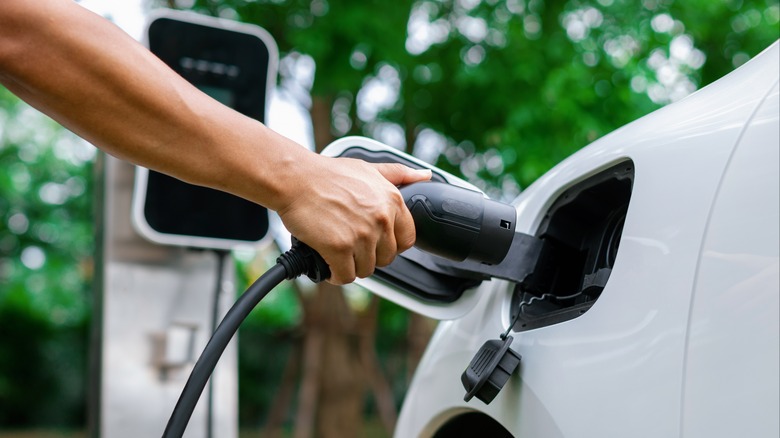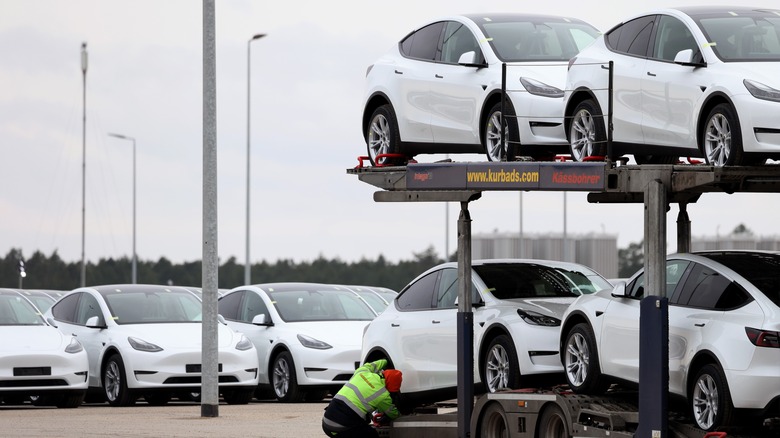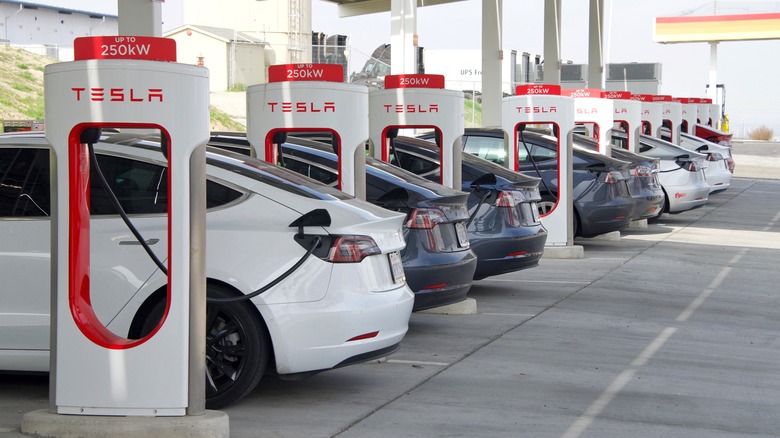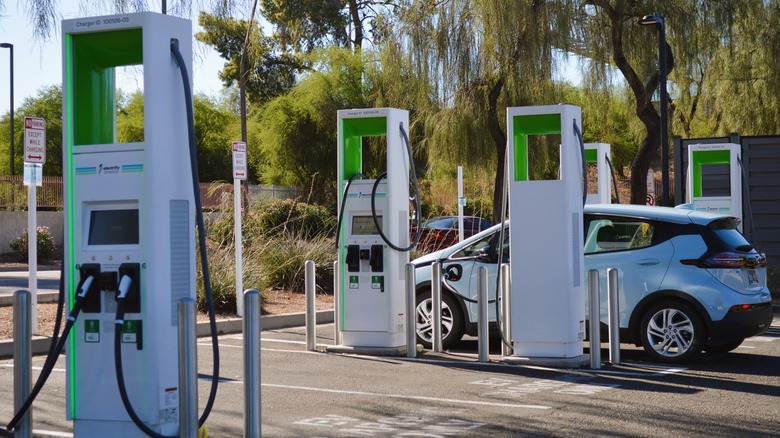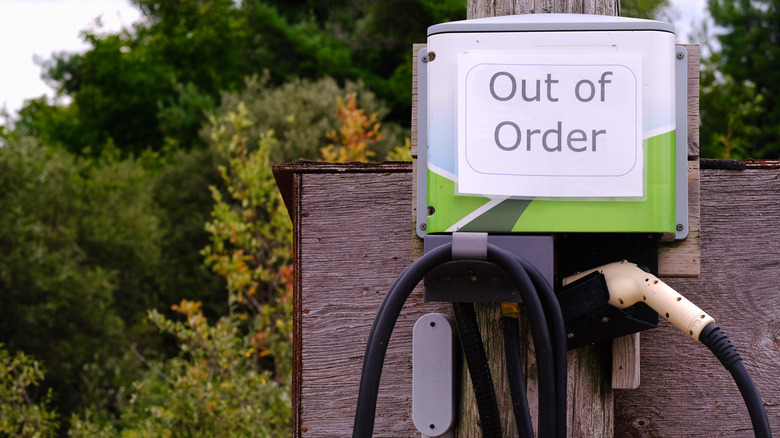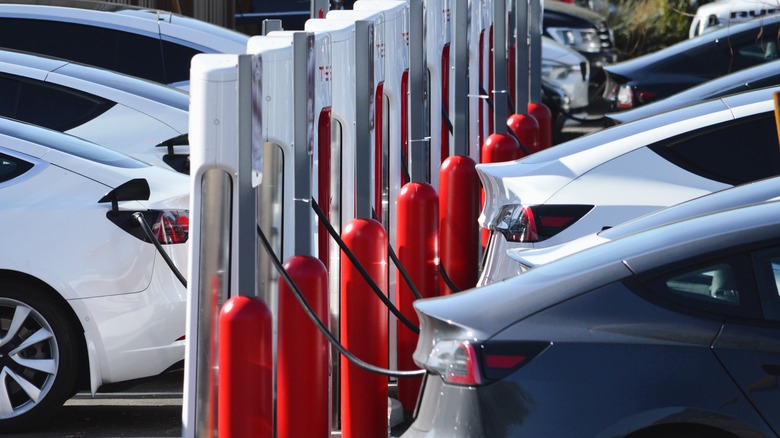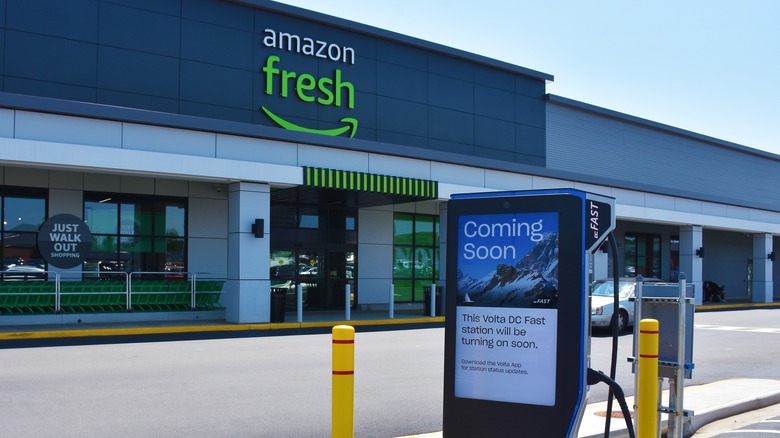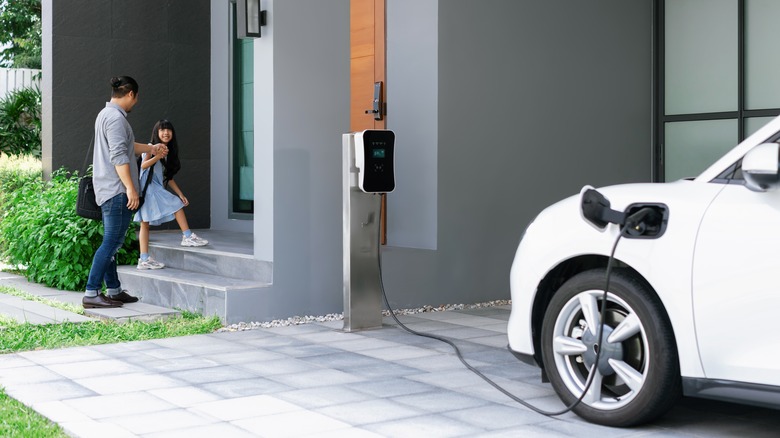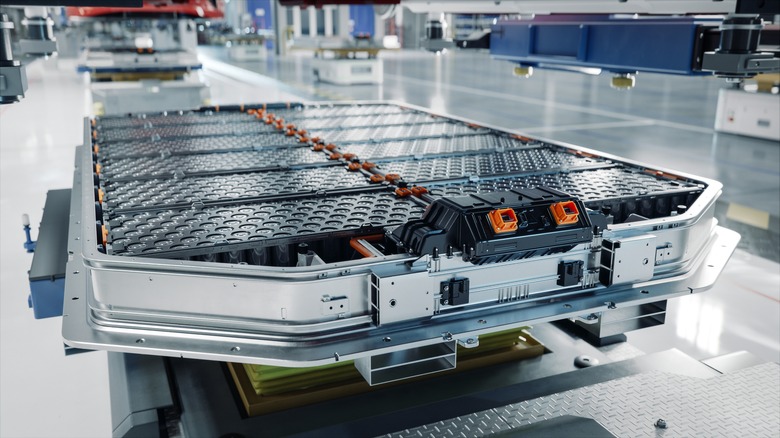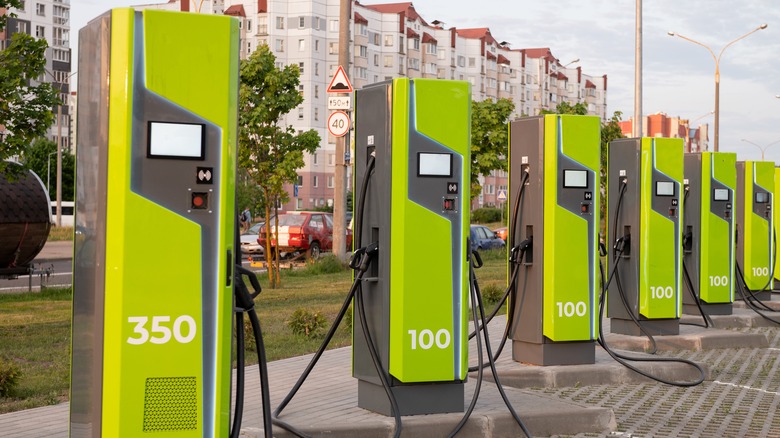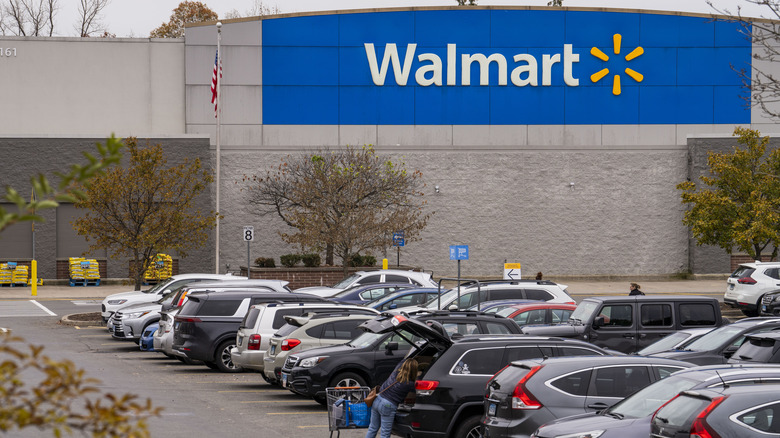Electric Vehicles And Infrastructure: Is The U.S. Really Ready For An EV Revolution?
The global automotive industry is undergoing its most significant transformation in living memory, as the world's biggest carmakers pour unprecedented amounts of cash into developing and manufacturing electric cars. In some parts of the world, EVs have already become the default option for car buyers — for example, in Norway, all-electric BEVs made up around 84% of overall new car sales in October 2023, according to CleanTechnica. This might seem surprising at first, as Norway's major cities are few and far between, spread out over vast distances with few towns in between.
Nonetheless, the country's comprehensive network of chargers means that even in remote areas, it's not difficult to get around with an` EV. This investment in infrastructure, combined with heavy incentives for electric cars and taxes on polluting vehicles, has led to a revolution in how buyers see EVs. However, with American charging infrastructure lagging well behind EV leaders like Norway, critics have questioned whether the nation could cope with a similar change in buyer habits.
EV sales are still growing
The question is becoming ever more pressing as data shows EV sales in America are rapidly growing. A study by Cox Auto revealed that 2023 is set to be the first year ever where U.S. EV sales reach over one million units, with the third quarter seeing record numbers of electric cars registered. A number of major automakers have seen their EV sales more than double compared to 2022, primarily due to the launch of new models. The same study estimates that the number of electric car models on offer will double again by 2027, meaning sales numbers are likely to keep on rising.
A major driver of this increased EV volume is the entry of a wider range of major automakers into the segment. While Tesla remains the biggest EV maker for now, its share in the segment has dropped to around 50%, even after dropping its prices significantly in an attempt to entice new customers. With so many new models from rival manufacturers on the way, the competition will only continue to get tougher.
Tesla and the Supercharger network
Despite the increased competition, Tesla continues to offer buyers a currently unbeatable advantage: full access to its Supercharger network. The original marque-specific charging network gives Tesla drivers access to fast charging all across America, and makes payment easy through the Tesla app. This goes a long way to helping ease the range anxiety that many first-time EV buyers have, as well as making it practical to undertake longer journeys with the car.
Tesla recently opened certain Supercharger locations to non-Tesla EVs, and is set to expand its range of locations soon. However, the brand's website notes that "future sites will only be opened to non-Tesla vehicles if there is available capacity," so it seems unlikely that the scheme will be rolled out to the entire network any time soon. Tesla drivers are also free to charge at any third-party charging station, subject to compatibility, and so benefit from the best access to nationwide charging infrastructure.
Rival charging options
While there's no way to match Tesla's network for now, drivers of non-Tesla EVs do have an increasing range of options at their disposal. However, accessing all these options is not always a simple task. A variety of charging apps are available and most networks are only compatible with one or two of them — that means that anyone looking to take advantage of the full range of charging infrastructure available to them will likely need a series of apps, each with its own payment system.
Another key issue with the current charging landscape is that many chargers are only Level 2, and not DC Fast Chargers. This drastically increases the amount of time it takes to recharge the car – EVGo estimates that its DCFC chargers can deliver 150 miles of range in 15-30 minutes, whereas a Level 2 charger will take anywhere between four to eight hours. It's worth noting, however, that these charging times can vary greatly between car models, as well as charger types. The Department of Energy lists nearly 60,000 publicly available charging stations at the time of writing, but less than 8,500 of those feature DC Fast Chargers.
Broken and faulty chargers
Adding to current infrastructure woes is the fact that it's annoyingly common to find chargers out of service, or otherwise unable to deliver a fast charge despite boasting fast-charging capabilities. It's one of the most common complaints among EV owners for good reason: It's no use having access to a charging station if the chargers themselves are inadequate. The government is well aware of the issue, and in September 2023, approved a $100 million package aimed at improving charging reliability. But for now it remains one of the biggest headaches of driving an EV.
Some of these headaches can be avoided by buying a Tesla — the brand claims its network uptime sits around 99.9%, and anecdotal evidence generally suggests Tesla owners have a much easier time than drivers of other cars. A key problem is that there's no clear way to measure this yet, as uptime doesn't necessarily mean that a charger is readily available to use. Rather, it simply means that it's responding to network requests, but there are plenty of other bugs or issues that could stop it from being functional.
Dispelling unhelpful myths
Tesla's network isn't perfect, even if it's still the leader in both charging availability and user satisfaction. However, it's worth noting that myths persist among EV cynics around Superchargers, particularly around wait times. The network has been the subject of disinformation aimed at discrediting EV infrastructure, such as a video that went viral in 2022 showing hours-long queues at a Tesla charging station in California.
It was shared without context and used by critics as evidence of Tesla's network inadequacy, but an investigation by Reuters found that the footage actually dated from Thanksgiving 2019. In the years since then, Tesla has significantly expanded its network, and now has over 2,000 stations in North America. This all matters a lot less, of course, to drivers of non-Tesla EVs. If anything, unhelpful viral clips like this can take attention away from the areas of infrastructure that most need improving today — and given the issues listed above, there are certainly plenty of improvements still needed.
Regional variation
Alongside issues with the electric charging stations that do exist, one of the biggest issues for EV drivers is that, in many areas outside major cities, there simply aren't enough stations built yet. The availability of chargers varies wildly by state: The likes of Montana, Idaho, and Wyoming have very few fast charging stations, and those that have been built are mostly clustered around major population centers. That makes longer interstate trips extremely impractical, and potentially even impossible for EVs with lower ranges.
In comparison, states like California offer much more comprehensive charging facilities. However, building new charging stations is a chicken-and-egg scenario: Buyers are much less likely to purchase EVs in areas where facilities are lacking, while companies are less likely to invest in building chargers in areas where fewer EVs are sold. A SlashGear reader survey found that this was the biggest concern most people had about buying an EV, and it's a problem that's unlikely to be resolved anytime soon, even with the introduction of federal funding initiatives that aim to broaden the EV charging network.
Home charging ubiquity
While a robust national charging network is vital for longer trips, it's not currently the primary way electric vehicle owners charge their cars. In fact, around 90% of charging is done overnight at home, according to the Department of Energy. There are a few approaches to take here: One might be to say that, since most drivers don't use the public network that often, home charging subsidies would be a more effective driver of EV adoption than investment into the public network. However, this argument overlooks several key issues.
The first is that a significant portion of U.S. drivers don't have access to a suitable space to install a charger — apartment owners, renters, or those living in shared accommodation all potentially fall into this category. Secondly, the fastest home chargers only offer Level 2 charging, and are therefore much slower than a fast-charging station.
Lastly, the issue of recharging on longer journeys is still a significant barrier to EV adoption, even if home chargers continue to be the most popular choice for owners. Unlike early adopters, mass-market buyers simply aren't willing to give up the convenience of easy refueling, and so to get them to make the switch from gas to electric cars, there is no other option but to continue expanding the fast-charging network.
The benefits of longer range
While charging network expansion is ongoing, another development in EV technology might go some way to lessening the challenges that U.S. charging infrastructure faces. A number of new, next-generation batteries are currently in development, with Toyota seemingly being the furthest ahead in the race to bring them to market. A recent press release detailed the world's largest automaker's ambitious plans, including bringing innovative solid-state batteries to commercial production by 2027-28. These batteries, according to Toyota, will boast ranges of up to 621 miles — significantly longer than most current gas-powered cars.
In addition, the brand aims to bring a "high performance" version of its liquid Li-Ion batteries to market with a similar range the same year. If it can deliver on its plans, the release of those batteries might have a huge impact on the EV market, as well as relieving some of the pressure on charging infrastructure. For context, the Harvard Business Review estimates the average American commute is 32 miles each day. Assuming a five-day commute to the office, a 621-mile range would allow for more than three weeks of commuting between charges.
Not only that, but Toyota claims fast-charging times from 10 to 80 percent would be reduced to as little as ten minutes with a suitably powerful charger. It's worth noting that these figures are all, for now, provisional. But, if these batteries become more widely adopted, visits to the fast-charging station might become a more infrequent affair for drivers.
Scaling up in time
A 2022 study by PwC estimates that American charging infrastructure will need to scale up by around ten times to meet market demand by 2030. The study predicts that on-the-road charging stations will form a relatively small part of that overall demand, with the biggest increases in charging availability coming from at-work charging stations and apartment buildings. Assuming most people are at work for around eight hours a day, this would allow workplaces to install Level 2 chargers, which are cheaper both to install and to maintain.
Retrofitting apartment buildings with chargers is predicted to form part of the solution, according to the study, but network expansion will also come from integrating chargers into the parking lots of newly built blocks. Overall, however, it's predicted that at-home charging will still remain the most popular way to recharge. Within the home-charging market, the study claims most chargers will be sold by car manufacturers, either as a standalone product or as part of a bundle with a new EV.
Corporate charging expansion
Another promising area of network expansion is destination charging — that is, chargers offered at stores, restaurants, and attractions. One of the most notable corporations to commit to building a charging network is Walmart, which announced earlier in 2023 that it intended to build its own branded network of chargers in stores across the country. Walmart already offers a number of third-party chargers across various locations, but the announcement committed to a more extensive rollout across "thousands" of Walmart and Sam's Club stores across the country.
This is potentially a win for both drivers and Walmart — drivers get a convenient place to charge their car while they're doing the grocery run, while Walmart gives EV owners a new reason to head to its stores. It's been speculated that, if the program is successful, it could incentivize other big chains to do the same thing, vastly increasing the number of chargers available to drivers. However, for now, it remains to be seen how quickly Walmart builds this new charging network, and how popular it proves to be with drivers.
Taking lessons from Norway
Norway is widely hailed as an electric car success story, and proponents of its policies have suggested that countries like the U.S. could look to it for inspiration. However, despite its highly effective initiatives aimed at driving EV adoption, there are still some issues that critics are keen to highlight. An analysis by Vox suggested that Norway's aggressive promotion of electric vehicles might have had negative effects on promoting other emissions-reducing modes of transport. In particular, some local policymakers argued that EV initiatives reduced the funding available to upgrade the country's limited public transit system, and discouraged bicycle use in cities.
Both bicycles and public transport are proven to be greener than electric cars, but tempting people away from cars is an extremely difficult task, especially in a country as car-centric as the U.S. In more rural areas, reducing reliance on cars is also a less feasible solution, but in densely-populated urban centers, it's potentially a very effective way to reduce both emissions and traffic congestion at the same time. So, while improving EV charging infrastructure should remain a key priority for American legislators — and make no mistake, rapid improvement is needed if national infrastructure is to keep up with rising EV demand — improving access to other transport options like zero-emissions buses, trams, and e-bikes might be just as key to delivering the American electric vehicle revolution.
